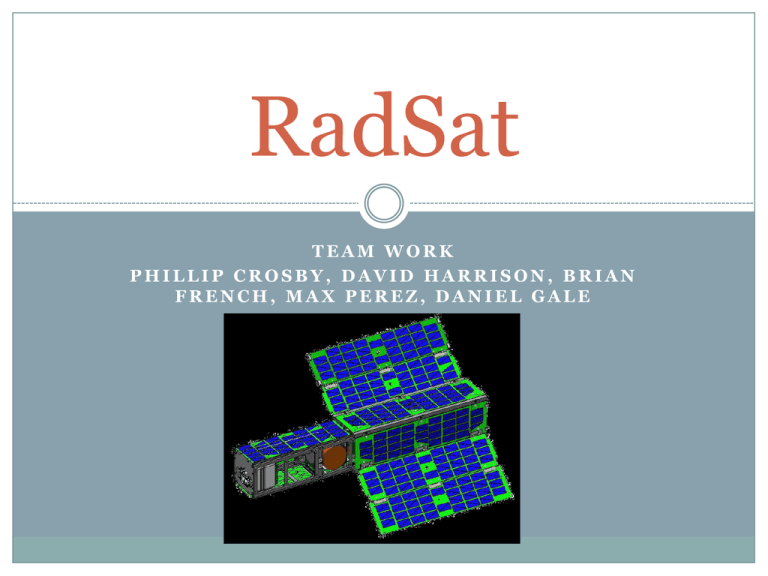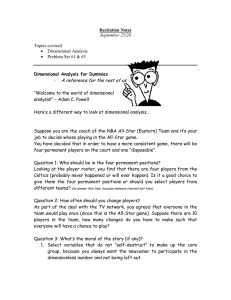RadSat
advertisement

RadSat TEAM WORK PHILLIP CROSBY, DAVID HARRISON, BRIAN FRENCH, MAX PEREZ, DANIEL GALE Theoretical Overview In recent years, scientist have come to a greater understanding of the effects of carbon-dioxide emissions, amongst other greenhouse gases, as it pertains to climate change. There exists a theory in the scientific community that a negative feedback cycle is being created that may temper some of the effects of climate change. Atmospheric Feedback As greenhouse gasses begin to raise the temperature of our atmosphere more water vapor is driven into the atmosphere. The increase in water vapor in turn generates more clouds and cloud cover. This increase in cloud cover may block, reflect, and scatter incoming sunlight – thus slowing the rate of climate change. Further inquiry into whether this phenomenon is active, and the extent to which it is active, will help our society to understand our climate and the manner in which we interact with our climate. Electromagnetic Absorption The primary mechanism that we will use to investigate this feedback phenomenon will be gathering atmospheric temperature data using a radiometer to observe high-frequency spectral absorptions to monitor and track the Earth’s temperature from a geosynchronous orbit about the Earth. Microwave Sounding Due to quantum mechanical effects of airborne compounds, primarily water vapor and diatomic oxygen, the Earth’s atmosphere selectively passes certain bandwidths of electromagnetic radiation while significantly attenuating others. Microwave Sounding: Frequency vs. Zenith Opacity 118.75 GHz The atmospheric frequency response surrounding 118.75 GHz offers a unique opportunity to study from space as it offers a number of advantages: Increased frequency resolution as compared to previously studied absorption bands near 60 GHz The emitted EM waves are less transparent to clouds Componentery used to study wavelengths on this level is just coming into it’s own and this band is largely untapped Combining data sets with 60 GHz data sets is expected to yield interesting observations Vertical Temperature Sounding Weighting Functions Interpreting Weighting Temperature Channels ALL-STAR RadSat Functional Decomposition: Level 0 Antenna Signal Processing ALLSTAR Functional Decomposition: Level 1 Horn LNA Mixer ANTENNA Signal Processing Detector Diode LPF ADC BPFs µC Physical Design Constraints The RadSat will be designed by implementing the 3U CubeSat specifications to be connected to the primary ALL-STAR system housing The length of the RadSat must be 6.5’’ x 2.5’’ x 2.5’’ The volume of the RadSat must be 40.625 in3. Must not exceed 2000 g Center of gravity must be located at the center of the RadSat. ALL-STAR System ALL-STAR (Agile Low-Cost Laboratory for Space Technology Acceleration Research) Master power and communications delivery platform Compatible with all 3U CubeSat satellites (including RadSat) ALL-STAR Capabilities Power distribution to payload (RadSat) A/D Converters GPS accuracy within 100 m Configuration memory 62.5 KB Data memory 3276.8 MB Attitude pointing accuracy: 1° Downlink rate: 250 kbps Uplink rate: 9.6 kbps ALL-STAR System Communication Handshaking from RadSat to the ALL-STAR bus Serial data will be exchanged using a pin-out connector Bus capable of transmission rates of 20 mbps ALL-STAR bus protocol will be used Error checking bits Continuation bit Frame number Frame length Frame data (Timestamp, Response, Type, Opcode, Length, Message, Checksum) ALL-STAR Power Constraints ALL-STAR Electrical Power System (EPS) Delivers 4-5 W of power continuously Can deliver 25 W of power for 15 minutes of every orbit Voltages available Unregulated Battery 12V 3.3V ALL-STAR Programming Concept ALL-STAR features will be programmed in C to accept RadSat packets . Address memory management of raw data Program weighting functions, send temperature data Interface between RadSat and MATLAB test surface via UART to be implemented. MATLAB and C will be used. RadSat’s command and data handling procedures will be written in C and programmed on the Xmega microprocessor Hardware Requirements Trigger ADC to sample Upwards of 10 channels Simultaneous sampling 16-bit resolution (pin-compatible to 24-bit resolution) Process data and pass samples to ALL-STAR Acquire a data point at no slower than 2 Hz to maintain spatial resolution Determined by orbital velocity and antenna -3dB angle Interface with the ALL-STAR bus Low Level Objectives Raw digital data is collected from RadSat where no additional data processing will be done. The raw data is sent to the ALL-STAR, and no additional data processing will be done. Medium Level Objective Raw digital data is collected from RadSat where no additional data processing will be made. The raw data is sent to the ALL-STAR where it is stored and information can be processed to obtain temperature data to transfer to ground station. High Objective Raw digital data is collected from RadSat where data will be processed and sent to the ALL-STAR in realtime. ALL-STAR receives already processed temperature data and stores in memory until downlink can be achieved Division of Labor Brian French Matlab test code programming RF test & assembly Maxwell Perez Operating system Programming bus interface Phillip Crosby Filtering RF assembly Documentation David Harrison Filtering Sensors: Temperature, Attitude Power management Daniel Gale Digital hardware PCB layouts firmware Schedule Schedule Milestone 1 Milestone 2 RF assembly completed Calibration systems and testing in progress Digital board nearing completion ALL-STAR interface completed and tested Firmware complete First and Second PCB layouts tested development in progress Third PCB layout and fabrication complete Miniaturization and Power management underway for RF Data acquisitioning and conditioning complete Budget Provided for us by Space Grant and Dr. Gasiewski Component Mixer Price $45,000 RadSat Will Provide Components $2000 x 10 $20,000 6 13 78.00 Microprocessor dev environment 1 40 40.00 20 15 300.00 5 12 60.00 ADC Passives PCBs Amplifier $15,000 Horn $5,000 Misc. Parts $10,000 Total $95,000 Total Cost Microprocessor RF Diodes Filter Quantity Price 30.00 3 66 198.00 Wire and Connectors 50.00 RF Connectors 50.00 FTDI chips 6 12 72.00 Power regulators 6 5 30.00 Current sensors 6 1 6.00 Temperature sensor 6 1 6.00 30 1 30.00 MOSFETs TOTAL = $950.00 Risks & Contingencies High power draw Table top model will Spatial constraints exceeded Finance Insufficient data capture High frequency is difficult to test Difficult to Demo Lack of experience with High Frequency RF have no power limit Table top model will have no space limit Space Grant and Dr. Gasiewski will provide financial backing Increase data capture as much as possible Use of test facilities at NIST and possible CU Labs Questions?




